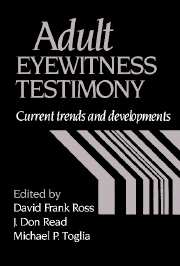Book contents
- Frontmatter
- Contents
- List of contributors
- Preface
- Part I Cognitive, physical and social processes and factors influencing eyewitness recall and identification
- Part II Lineup construction and collection of testimony
- 8 Conceptual, practical, and empirical issues associated with eyewitness identification test media
- 9 Biased lineups: Where do they come from?
- 10 Evaluating the fairness of lineups
- 11 Recommendations for properly conducted lineup identification tasks
- 12 Improving eyewitness testimony with the Cognitive Interview
- Part III Whom to believe? Distinguishing accurate from inaccurate eyewitnesses
- Name index
- Subject index
12 - Improving eyewitness testimony with the Cognitive Interview
Published online by Cambridge University Press: 04 August 2010
- Frontmatter
- Contents
- List of contributors
- Preface
- Part I Cognitive, physical and social processes and factors influencing eyewitness recall and identification
- Part II Lineup construction and collection of testimony
- 8 Conceptual, practical, and empirical issues associated with eyewitness identification test media
- 9 Biased lineups: Where do they come from?
- 10 Evaluating the fairness of lineups
- 11 Recommendations for properly conducted lineup identification tasks
- 12 Improving eyewitness testimony with the Cognitive Interview
- Part III Whom to believe? Distinguishing accurate from inaccurate eyewitnesses
- Name index
- Subject index
Summary
In a comprehensive study of criminal investigation processes, the Rand Corporation (1975) reported that the principal determinant of whether or not a case is solved is the completeness and accuracy of the eyewitness's account. This official document mirrors the feelings unofficially held by many law enforcement agents (Sanders, 1986). Defense attorneys have made similar claims: The more evidence they can marshal, the better they can defend a client (Visher, 1987). In short, all concerned profit from having more complete and accurate eyewitness evidence. The criminal is more effectively pursued and tried; the innocent person is less likely to be harassed by the police or falsely convicted.
Despite the obvious importance of eyewitness evidence, police receive inadequate training in conducting effective interviews with cooperative eyewitnesses (Sanders, 1986). A poll of American police departments revealed that more than half had no formal training whatsoever for newly appointed investigators (Rand Corporation, 1975). A comparable lack of systematic training was found for British police (Cahill & Mingay, 1986). Most textbooks in police science either completely omit the issue of effective interviewing techniques or provide only superficial coverage (although see Flanagan, 1981, and Wells, 1988, for notable exceptions).
How do police learn to conduct eyewitness interviews? Typically, they either observe and try to emulate the style of a senior officer or they learn by trial and error. Often they are given a checklist of evidence to be gathered and are left on their own, without guidance, to elicit the information. It should not be surprising that police investigators (and others equally untrained, like attorneys or accident investigators) frequently make avoidable mistakes and fail to elicit potentially valuable information.
- Type
- Chapter
- Information
- Adult Eyewitness TestimonyCurrent Trends and Developments, pp. 245 - 270Publisher: Cambridge University PressPrint publication year: 1994
- 20
- Cited by

